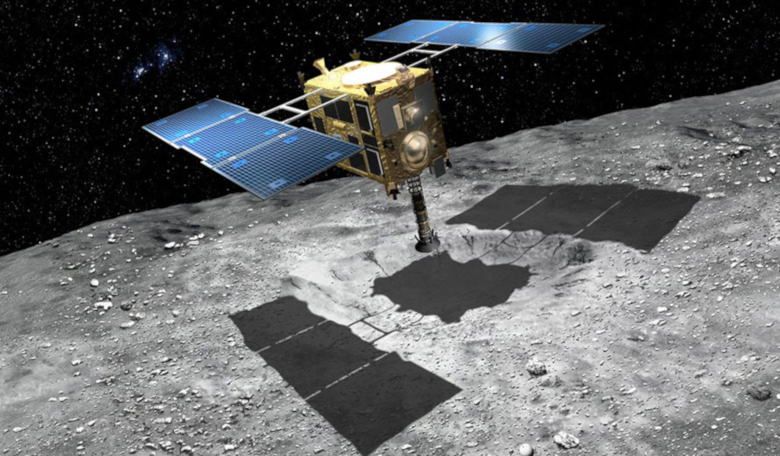On Sunday 6th December, after completing a round-trip of approximately 5.2 billion kilometres, Japan’s asteroid sample-return mission – Hayabuya2 – will drop samples of an ancient rock on to a remote test range in the Australian outback; a journey which has taken just over six years to complete.
Expected to land in the dark in a sparsely populated area of Woomera, if all goes well, the return capsule, which is just 40 centimetres in diameter, will have achieved a landing target accuracy the equivalent of someone throwing a ball from more than half the distance to the Moon (so around 220,000 km) to a 100 square kilometre spot on the surface of Earth.
On hand will be the awaiting Hayabusa2 collection team, who are hoping to locate the return capsule with its beacon signal.
“Five antennas will be installed around the expected landing site, which will each record the direction of the signal. These directions will be reported to the headquarters and when plotted on a map, the intersection will reveal the position of the signal source,” say the Japanese Aerospace Exploration Agency (JAXA).
If for some unforeseen reason the capsule cannot be located, the team hope that the capsule’s parachute can be picked up with a marine radar system, which uses four stations deployed around the expected landing area.
Drones will also be used in the event the capsule cannot be located.
Once the capsule has been found, a number of safety checks have to be completed before the parachute and heat shield can be separated.
Then, providing no damage to the capsule or leakage of the sample has been found, the capsule will be taken to headquarters by helicopter for cleaning and gas sampling in a clean room, if deemed appropriate by an Australian safety officer.
“I am anxious and excited about how much sample has been collected, but if we find something in the gas analysis, my expectations for the results will grow greatly,” says Hayabusa2 project member Satoru Nakazawa.
Hayabusa2 has had two attempts at collecting material from Ryugu during its rendezvous with the near-Earth asteroid.
It’s first effort in February last year followed straight after the probe touched down on the asteroids surface and involved firing a metal projectile into the rocky surface to collect any dislodged debris it could grab.
The spacecraft then 'bombed’ Ryugu with a small softball-sized copper ball six weeks later to reveal pristine material that lay hidden beneath the surface.
Ryugu appears to be a “rubble pile” carbonaceous asteroid that has coalesced from scraps of rock set loose when planetary objects collided.
Scientists are hoping that the fragments collected from this primordial space rock will therefore provide clues to the origin of the Solar System and possibly even life on Earth.
The rock and dust samples should also tell us how long Ryugu has been orbiting in close proximity to Earth.
With just a couple of days to go before the return capsule plummets to Earth, Hayabusa2 appears to be flying smoothly according to plan, Yuichi Tsuda, project manager at the Japan Aerospace Exploration Agency (JAXA), said at a recent briefing.
“We trained ourselves and now we are fully prepared. So I’m just praying that equipment that hasn’t been used yet will work well and that there will be good weather in Australia,” Tsuda said. “We are so excited.”
As Tsuda and colleagues get ready to start work on this extraordinary material here on Earth, Hayabusa2 on the other hand will be heading back out into space.
Once the capsule has been released, the probe will make its way to 1998KY26, a nearly spherical sub-kilometre asteroid located between the orbits of Earth and Mars.
The spacecraft is expected to start examining its new target in 2031.











